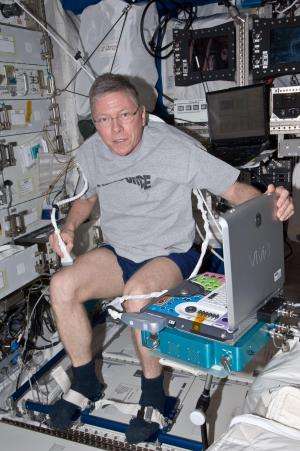Move it or lose it: One-year mission video miniseries

Have you ever noticed after lying in bed sick for a few days that standing upright took you a moment to regain your balance? Or perhaps you have an aging grandparent who spends more time lying in bed than standing and you had to help them up because they have not used their leg muscles in a while? After living aboard the International Space Station, research into this area of physical performance may hold answers for those living with challenges from health-related concerns from prolonged inactivity.
As part of NASA's One-Year Mission, researchers will conduct several Human Research Program investigations on the space station. The goal is to learn more about how the body responds to a long-term, low-gravity environment. These investigations are grouped into seven categories: visual impairment, physical performance, functional, behavioral health, human factors, metabolic and microbial.
In weightlessness, our bones and muscles are essentially in a resting state like lying in bed. On Earth, however, gravity is pulling and working on our muscles and bones whether we realize it or not. The heart muscle, for instance, has to work harder on Earth to pump blood into areas above the organ, counteracting gravity that naturally pulls the blood in a downward direction. Therefore, it is extremely important that astronauts exercise every day of the week in space to keep their bones and muscles healthy.
The physical performance category will include investigations designed to enhance our knowledge of the effects of weightlessness on bones, muscles and heart.
The Sprint investigation evaluates a new exercise regimen involving higher intensity, less frequent tasks. The goal is to minimize loss of muscle, bone, and cardiovascular functions that can occur over long periods in space.
The Hip quantitative computed tomography (Hip QCT) study will help define the risks for early onset osteoporosis and bone fracture due to long duration spaceflight. The results of this research may be of benefit to individuals on Earth with similar symptoms such as early onset osteoporosis.
NASA's Human Research Program enables space exploration beyond low Earth orbit by reducing the risks to human health & performance through a focused program of basic, applied and operational research. This leads to the development and delivery of: human health, performance, and habitability standards; countermeasures and risk mitigation solutions; and advanced habitability and medical support technologies.
Provided by NASA




















